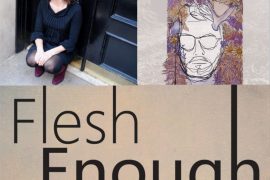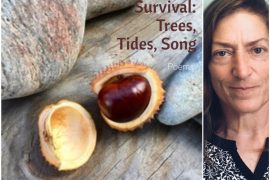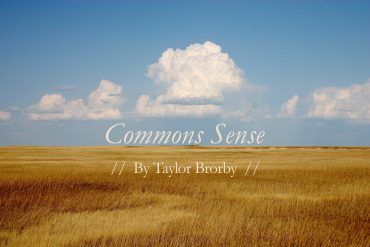Award-winning Australian author Robbie Arnott’s first book to be published in the United States, The Rain Heron, out this month from Farrar, Strauss and Giroux, follows three different characters in a story about mythical creatures, environmental degradation, and the traumas that inform our actions and relationships. In an unspecified country devastated by a coup d’état, Ren moves to the mountainous forest to live outside the military order which rules those who remain in society. However, the military infiltrates her refuge when a small army unit arrives in search of the rain heron, a legendary creature said to have the power to change the weather. As their search for the rain heron intensifies and results in near-fatal battle between Ren and the army unit’s leader, Lieutenant Zoe Harker, the back-stories and traumas of those involved slowly unravel into an enrapturing tale of myth, climate change, and capitalist destruction.
Split into five parts, the first and shortest section, or “Part 0,” details the myth of the rain heron, its tone echoing that of a fable told to children at night—and as we soon learn, the myth takes exactly this cultural place in the novel’s nameless country. In the next parts, we move from Ren’s adjustment to life in the forest and the ruptures caused by the army’s arrival, to Zoe Harker’s childhood upbringing in a small town built around a second magical animal, to the perspective of the young medic in her unit, Daniel, and finally back to Zoe’s experiences after quietly slipping away from the military, plagued by festering wounds both physical and mental. Throughout these temporal fluctuations, themes of environmental and social collapse, interpersonal tension, and the lingering effects of buried trauma bind the sections and the characters together.
The subtle magic of the harmony between humans and nature abounds in Arnott’s descriptions of the two mystical creatures: the rain heron and the squids of Zoe’s childhood. As a child, Ren’s grandmother takes her to see the rain heron for the first time, a bird that “looked like a heron, although it was too big, too blue, too alien. Huge and silent, it was running its long beak through its pale cerulean plumage. . . . Water was dripping from the feathers as the bird preened, shedding in a stream of moisture that fell and collected at the base of the tree.” When the bird flies above them, its power to control the weather is displayed, “shaking ice and dew across the clearing over Ren and her grandmother,” and finally diving into the small tarn below, where “it caused no splash, made no ripples. It was as if the bird had become one with the water, rather than sinking beneath its surface.” In Zoe’s childhood town, the local trade centers around another mystic creature. The townspeople harvest a magical ink from squid, coaxing them into a state of relaxation by offering them drops of their own blood, fresh from small cuts on their arms. After feeding the squid with their blood, the squid turn a multitude of colors and release their ink peacefully, then return to the depths of the ocean. “Blood for ink. A simple trade,” writes Arnott of this traditional practice.
Both the rain heron and the squid, however, pose a great danger to those who attempt to interfere with the balance between humans and nature. In the legend of the rain heron, a farmer becomes jealous of the prosperity brought to his neighbor by the heron’s rain, and in return for attempting to harm the magical bird, the heron bites out his eyes, blinding him. Similarly, when a mysterious northerner comes to Zoe’s small town and attempts to harvest ink from the squid by force after the townspeople refuse to divulge their ways, they find him in the middle of the street covered in wounds: “Scratches, bruises, cuts—he looked like he’d been in a road accident. His hands were the worst. They had been flayed, as if he’d been whipped or slashed, with skin hanging in strips from his fingers and the rent webbing between them. One thumb was shorn of its nail. Ice had filmed over the exposed meat. But despite these injuries he was still smiling . . . Behind him was the misshapen, colourless hulk of a dead squid.”
This northerner and his restless plight to reap ink from the squid introduces another prominent theme of the novel—that of the dangers of environmental degradation in the name of capitalist exploitation. Arnott writes of the many products of the squids’ ink:
The ink was sold to people from the north, then churned, vaporised, and used to make perfectly antiperspirant deodorant that rendered pores sweatless and odourless for up to three days. It was added to sauces and stews to create a rich, meaty-fishy flavour, or mixed with vegetable gum and powdered horse hooves into a paste that was sold as industrial-grade engineering glue. It was greased onto engines to provide unusually long-lasting lubrication, and it was brewed into a black wine that hit the tongue like a sweet ocean breeze. But it was most commonly used as dye.
When mixed with other colours of dye (or paint or chalk or lesser inks) it vastly enhanced the qualities of that colour, in the same way that salt brings out depth of flavour in food. Adding it to a matte red would bring out a pop of open-vein crimson, while mixing it with a basic purple would create violent blinks of violet. It lent a soft, mossy texture to an average dark green, and a navy depth to dark blue that was so strong it brought about the smell of the sea. White shone brighter; orange shimmered like a sunset. Pale blue became so skylike it made one forget about the existence of clouds.
Despite the ink’s manifold uses, for which one might assume the good would be turned into a mass-produced monoculture, the process of harvesting in the town remains small and centered around the equal trade of blood for ink, never harming or disturbing the squid from their natural habitat. The northerner, however, comes to the town with a greater revenue in mind. In an attempt to persuade the townspeople to teach him their ways, he claims that he does not want to “plunder the town’s resource in harsh, destructive ways,” but rather to “build a sustainable fishery that produced greater yields of ink, yields of ink, yields that would benefit them all . . . He wanted to walk with them into the future, he said, hand in hand.” Yet despite his promise of a sustainable practice, the northerner ends up killing countless squid in his attempts to procure and manufacture the ink. Here, Arnott questions the luster of some forms of sustainable expansion as a benevolent practice when it might still pose great danger not only to the squid but to the northerner himself, who endures countless wounds from his battles with the creatures. The northerner’s words of “walking with them into the future” additionally bring to mind the possibility that some “sustainable” practices can claim respect for ancient traditions and practices but still move in the way and name of capitalism, leaving destruction in their wake.
The northerner’s relentless assault on the squid also mirrors the way that Zoe later pressures Ren into divulging the location of the rain heron by destroying the natural world around her and cutting off her ability to sustain herself—suggesting that Zoe perhaps learned the quintessential “methodical disintegration of resistance” for which she is celebrated in the military from her experiences watching the northerner destroy and maim the squid in her hometown until she finally gave him what he wanted in an attempt to stop the harm. As she kills trees, pollutes the water, and destroys the natural environment around Ren until she is forced to give in to Zoe’s demands, Ren sees her as a destructive force of pure evil: “For Harker, the mountain was no different to a car park, an office, the bottom of the ocean; she would use it, take what she needed, burn it down, dance gracefully in the ashes and never think of it again. Ren could tell: she had seen it in her smooth face, heard it in her placid voice. She knew the type.” Yet behind these two horrendous endeavors of environmental degradation, we learn that neither the northerner nor Zoe wanted to carry them out: they were instead pressured by external forces—the military generals behind Zoe, and some unnamed “dangerous people” who threatened the northerner unless he procured the ink. By adding in this final detail, Arnott points to the greater systems at work behind individual acts of destruction and climate change, both ultimately leading back to the mysterious coup d’état about which the reader learns very little.
Connected as well to the concept of interrelated systems instigating individual acts is the deeply rooted examination of trauma at the heart of The Rain Heron. One of the first things that Ren thinks upon seeing Zoe traipsing through the woods is that she could be her daughter, a thought that reappears multiple times without further explanation, much like an intrusive thought, until Ren collapses into Zoe’s lap after being worn down: “Worst of all, it reminded Ren that she’d never had a daughter—only a son. A son she tried so hard not to think about. A son who’d driven her to this mountain by becoming something not unlike the woman stroking her neck.” In this small, measured confession—the only real glimpse into Ren’s previous life—Arnott alerts the reader to the lingering shadow of a relationship gone awry, a wound so deep that it pushed Ren to seek the furthest escape from anything that would remind her of her pain. Similarly, in the next section, Arnott hints to the unnamed trauma of Zoe’s aunt, the woman who raised her, through the pervasiveness of her laughter, which takes the form of a regulating response for both Zoe—who learns to expect laughter—and her aunt:
Then she would laugh, because Zoe’s mother was dead. Her aunt didn’t find that funny—she laughed because she laughed at everything. It was the only response she was capable of, regardless of the situation. She laughed at jokes and television, but she also laughed at food and trees and weather reports. Breakfast made her laugh, as did rain, splinters and trousers. She laughed at good fortune and horror. The more tense or difficult the circumstances, the wilder she laughed. When she learned that her sister—Zoe’s mother—had died, she screamed, bit her check and cackled, spraying blood from her mouth across a tiled floor.
Later on, Zoe herself is haunted by images of her aunt, the northerner, and Ren, which successively replace each other, burning into her mind and tormenting her, causing her to doubt her own memory. What we see in these moments are snapshots of people shaped by traumas we barely know. As readers, we only come to learn Zoe’s trauma intimately, but even her story is steeped in the lingering effects of unknown trauma, as she is surrounded by the death of her mother, her aunt’s laughter, and the northerner’s fear of retribution. While Ren’s trauma leads her to the mountain, Zoe’s leads her to enlist in the military, where she reenacts the cruel method of disintegrating her opponent’s resistance which she learned from the northerner’s actions. Here, Arnott perhaps suggests the lineage of trauma which informs our every act, the choices we make, yet intimates that the full story is so rarely ever accessible to us.
From the first fable of the rain heron to its moments of crisp lucidity, Arnott’s second novel enraptures the reader in a sense of awe. His prose often features a poetic touch, such as in one of the paragraphs which stuck with me for weeks after my first read: “How much blood runs in a body? Too much, I think. Too much to stay in precious equilibrium, whenever the skin’s dam bursts.” At other times, characters seem to take on animal qualities, a choice which echoes the aura of human and nature convergence in which the entire novel is submerged. The Rain Heron is a truly spellbinding tale of environmental caution, capitalist retribution, reverberating trauma, and our hidden urge to believe in the fantastical in equal measure.





